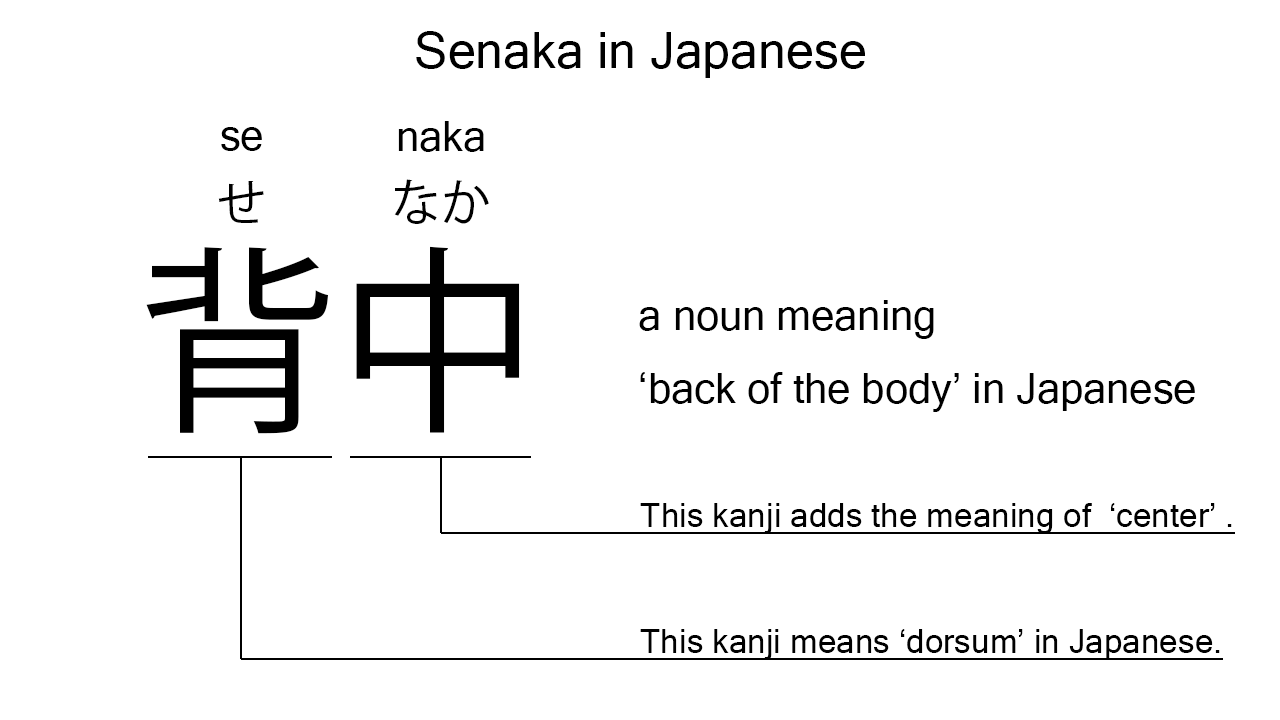What does “senaka” mean in Japanese?
Native speakers say “senaka” to mean ‘back of the body’ in Japanese. Perhaps, some Japanese learners know this word as it is sometimes used in Japanese conversations. In this blog post, however, I will explain this word in detail based on its kanji expression. And also, I will explain how to use it through example sentences. My explanations would help Japanese learners understand “senaka” more clearly. Then, let’s get started!
Contents
Definition and meaning of “senaka”
Let me start with the definition and meaning of “senaka”.
- senaka – 背中 (せなか) : a noun meaning ‘back of the body’ in Japanese.
The definition and meaning are simple and clear. To understand this noun more clearly, however, let me explain its kanji characters in detail, one by one.
What does “senaka” literally mean in Japanese?
The kanji expression of “senaka” consists of the following two kanji characters:
- 背 : a kanji character used to mean ‘dorsum’ or ‘height’ in Japanese.
- 中 : a kanji character often used to add the meaning of ‘center’.
From these two kanji characters, we can understand that the formed noun literally means ‘the center of the back side of the body’ in Japanese. This literal interpretation is more or less in line with the actual meaning.

When we meet new kanji expressions, we should check their kanji characters in detail to understand their meanings clearly and deeply. In many cases, kanji characters tell us a lot about the meanings of the expressions they form. Actually, here, we could get the better understanding of “senaka” through the detailed kanji check above.
So far, I’ve explained the definition and meaning of “senaka” together with its kanji characters. Then, let me explain how to use it through the example sentences below.
Example #1: how to say “back” in Japanese
kanojo no senaka wa utsukushii desu – 彼女の背中は美しいです (かのじょのせなかはうつくしいです)
Her back is beautiful.
Below are the new words used in the example sentence.
- kanojo – 彼女 (かのじょ) : a pronoun meaning ‘she’ in Japanese.
- no – の : a case particle used after a noun or pronoun to make its possessive case. In the example, this is used after “kanojo” to make its possessive case, “kanojo no”, which means ‘her’ in Japanese.
- wa – は : a binding particle working as a case marker or topic marker. In the example, this works after “kanojo no senaka” to make the subject in the sentence.
- utsukushii – 美しい (うつくしい) : an i-adjective meaning ‘beautiful’ in Japanese.
- desu – です : an auxiliary verb used after a noun or adjective to make it polite. Probably, this is well known as a part of Japanese desu form. In the example, this is used after “utsukushii” to make it sound polite.
This is a typical usage of “senaka”. In this example, it works together with the possessive case, “kanojo no”, to mean ‘her back’ in Japanese. When we want to refer to the back side of someone’s body in Japanese, this noun is a very good option.
Example #2: another usage of “senaka”
kare wa boku no senaka wo oshi ta – 彼は僕の背中を押した (かれはぼくのせなかをおした)
He encouraged me.
Below are the new words used in the example sentence.
- kare – 彼 (かれ) : a pronoun meaning ‘he’ in Japanese.
- boku – 僕 (ぼく) : a pronoun meaning ‘I’ in Japanese. This is used mainly by boys and young males.
- wo – を : a case particle used to make the object word in a sentence. In the example, this is used after “boku no senaka” to make the object in the sentence.
- oshi – 押し (おし) : one conjugation of the verb, “osu”, which means ‘to push’ in Japanese. In the example, it has been conjugated for the better connection with its following word.
- ta – た : an auxiliary verb used after a verb, adjective, or auxiliary verb to make its past tense form. Probably, this is well known as a part of Japanese ta form. In the example, this is used after “oshi” to make its past tense form, “oshi ta”.
This is another typical usage of “senaka”. In this example, it works as a part of the commonly-used phrase, “senaka wo oshi ta”, which is often translated into English as ‘to have encouraged’, ‘to have supported’, or such. The literal meaning of the phrase is “to have pushed someone’s back”, though.
Summary
In this blog post, I’ve explained the definition and meaning of “senaka” in detail based on its kanji expression. And also, I’ve explained how to use it through the example sentences. Let me summarize them as follows.
- senaka – 背中 (せなか) : a noun meaning ‘back of the body’ in Japanese. These two kanji characters literally mean ‘the center of the back side of the body’ in Japanese. This literal interpretation is more or less in line with the actual meaning.
Hope my explanations are understandable and helpful for Japanese learners.